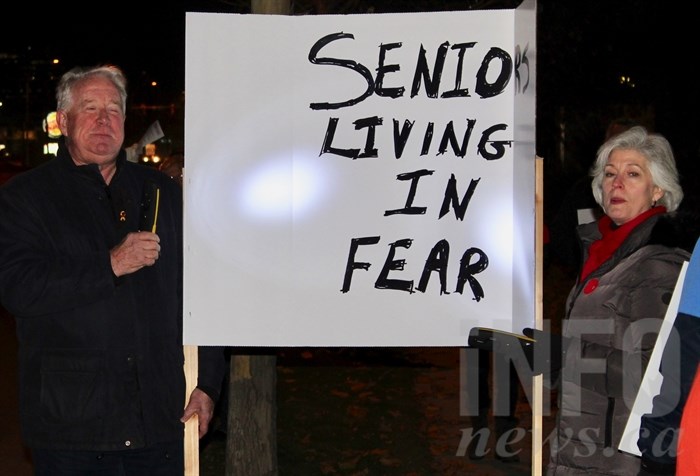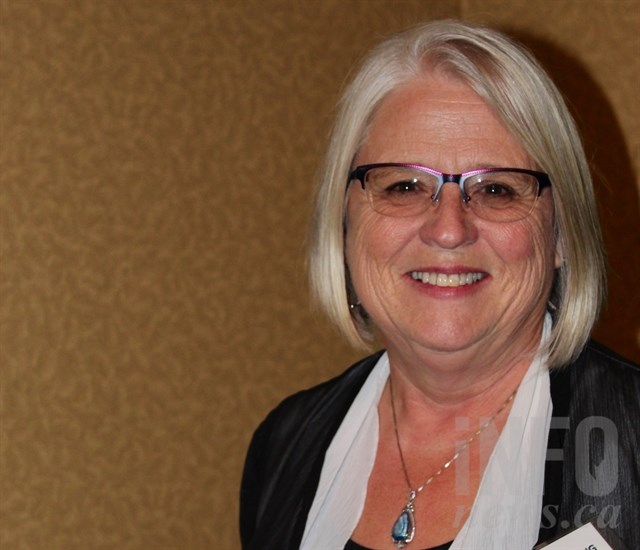
Protesters lined the street outside the Ramada Hotel in Kelowna, Thursday, Nov. 8, 2018, objecting to a proposal to house homeless people in their neighbourhood.
(ROB MUNRO / iNFOnews.ca)
November 09, 2018 - 11:47 AM
KELOWNA - Round two in the fight to house homeless people in Kelowna ended in a standoff last night.
Round one started in mid-October when concerned citizens attacked a proposal by B.C. Housing to build a 52-unit housing complex on Agassiz Road south of Orchard Plaza aimed at cutting into the waiting list of 500 people seeking homes.
Round three won’t be fought until next year.
An open house at the Ramada Hotel last night, Nov. 8, saw picket lines on the sidewalk outside, security guards inside and the proponents extolling the benefits of getting people, who happen to be homeless, into housing that will help them turn their lives around.
“It’s the seniors we’re worried about,” said Don Davies, who was holding up a sign that read “Seniors Living in Fear”.
“They don’t have a voice. We’re their voice.”
Opponents to the project say their neighbourhood is the second densest neighbourhood in Kelowna.
They say there is a large number of single senior women who are terrified of having a bunch of drug addicts move into their neighbourhood and B.C. Housing is hiding the fact that this is a “wet” facility, meaning people who live there can drink alcohol or take drugs inside the building.
They add there is a desperate need for more supportive housing for seniors, which is part of B.C. Housing’s mandate.
Inside the Ramada, there was a security guard to “escort” visitors to the meeting room. He said that is normal procedure but some others pointed out that people could not come onto a private property carrying signs.
There was other security staff in and around the meeting room, which had more than a dozen display boards around the walls and tables for people to provide written feedback.
The display boards dealt with property values, the Journey Home homeless strategy, floor and site plans, support services and who will live there.
Just as the protesters said, there was nothing about it being a “wet” facility but plenty of people to say that term isn’t used any more, although one board member mentioned staff would be on site to assist people in “stabilizing” - a term sometimes used by workers in the homelessness field to refer to people trying to get their addictions under control.
There was no written mention of the building having a safe injection site with overdose kits available with staff to supervise the injections.
“People (attending the open house) were primarily concerned with people doing drugs in the building,” said Gaelene Askeland, executive director of the John Howard Society that will manage the facility if this project goes ahead. “It’s a harm reduction building. Some residents will have addiction challenges.”
The idea of allowing people to consume drugs and alcohol in their own homes is no different in supportive housing projects than in the general population, said Ann Howard, B.C. Housing’s Regional Director for the Interior, which is funding the project.

Ann Howard, Interior Regional Director for B.C. Housing.
(ROB MUNRO / iNFOnews.ca)
“The buildings that exist right now in that (Agassiz) neighbourhood, if you ask them (residents): do you know there is drug abuse in your building, they say yes,” she said. “If you ask them: do you know there is alcohol abuse in your building, they say yes. What’s different here is that people here are homeless. They’re not as fortunate as some of those living in these other buildings.”
Howard went on to comment on some of the neighbours’ other concerns.
On density.
“Where’s their proof (that this is the second most dense neighbourhood in Kelowna),” she said. “This is a residential neighbourhood. That’s usually where residential housing goes.”
On a high concentration of seniors.
“There will be seniors in this project,” Howard said. “There won’t only be seniors. In the property next door, they’re not all seniors.”
On there being a bunch of drug addicts in the neighbourhood, others - who would not let their names be used because they were not authorized to be quoted - pointed out that residents are carefully screened and are not all homeless because of drug issues, that there would be a safe injection site inside the building and their experience with such facilities does not show residents wandering the neighborhood doing drugs.
Experience with other supportive housing facilities show the opposite to be true.
A good example is the 39-unit Tutt Street project across that small street from Raymer Elementary School.
As with all the other supportive housing projects in the city, it met with strong opposition when it was proposed back in 2011.
“Now the school brings food baskets,” Howard said.
Part of the effort at the open house was to get people to understand just what supportive housing means.
It’s a determined effort to bring people out of homeless shelter and out of precarious housing and into a safe environment where they can make positive changes in their lives.
They are carefully screened by people from a number of agencies to make sure there is a healthy mix of individuals. But the key criteria is that they have not only experienced homelessness but are judged capable of making positive changes in their lives once they have secure housing. Some may have drug or alcohol issues. Some may be brain damaged or have other mental health issues.
There is staff inside these facilities and at outside agencies who work with the residents to help them improve their lives and the facilities have a minimum of two trained staff at all times.
Askeland noted that neighbours’ attitudes usually change after these facilities get built and operate for a while.
That was certainly true of at least one business (That Pottery Place) across the street from the recently opened Harthstone House that provided hand-made coffee mugs to all residents moving in. And that is true of a number of businesses near the Cardington Apartments on St. Paul Street who only had good things to say about that facility.
While those are in more commercial areas, Gordon House (across from Capri Centre Mall) backs onto a residential neighbourhood like similar facilities in other cities.
“My vision for this, a few months down the road, if it gets built, is that there are neighbourhood barbecues where people get to know each other,” Askeland said.
As there seems no backing off on positions here, round three now goes to Kelowna City Council.
Howard did not know just where the rezoning application is with the city but, if it’s not already filed, it will be soon.
A public hearing will follow, likely in early 2019.
While rezoning usually deals with the form and character of projects and whether they fit with the Official Community Plan’s expectation for that property’s use, it’s clear that city council will be asked to deal with the character of the people who may live there.
Just in case council supports the rezoning application, protesters have also threatened going to court demanding a judicial review of the land purchase.
To contact a reporter for this story, email Rob Munro or call 250-808-0143 or email the editor. You can also submit photos, videos or news tips to the newsroom and be entered to win a monthly prize draw.
We welcome your comments and opinions on our stories but play nice. We won't censor or delete comments unless they contain off-topic statements or links, unnecessary vulgarity, false facts, spam or obviously fake profiles. If you have any concerns about what you see in comments, email the editor in the link above.
News from © iNFOnews, 2018